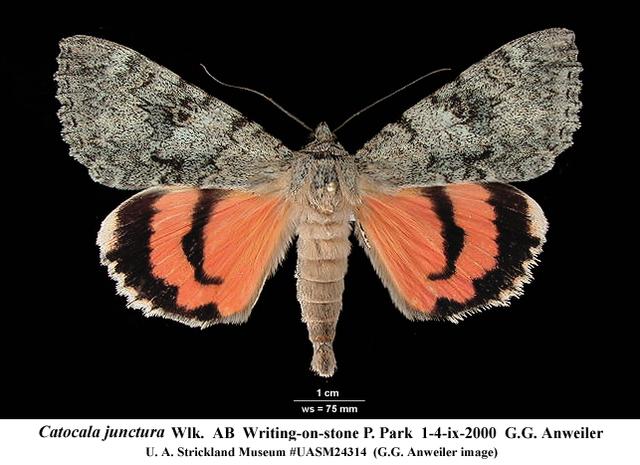Species Details
Catocala junctura
University of Alberta E.H. Strickland Entomological Museum Read more about this collection »
Common NameJoined Underwing
SeasonalityAdults fly in Alberta in late August and early September.
IdentificationOne of the largest (7.2- 8.5 cm wingspan) Alberta underwing moths. The forewings are a smooth evenly powdered blue-grey, with few markings. The doubled reniform spot and the lower end of the postmedian band where it crosses the fold are the most prominent markings. The hindwings are salmon or orange-pink as in parta and luciana, not red-orange as in unijuga and meskei or bright pink as in hermia and concumbens. The hindwing black median band is narrow and turns in sharply at the lower end, and in some specimens may have a small separate spot at the lower end as does C. meskei. The fringe is white and the antennae are simple, and both sexes are essentially alike.
Scientific Name
Catocala junctura
Common Name
Joined Underwing
Habitat
In Alberta, riparian cottonwood-willow groves in the valleys of the arid southern grasslands region.
Seasonality
Adults fly in Alberta in late August and early September.
Identification
One of the largest (7.2- 8.5 cm wingspan) Alberta underwing moths. The forewings are a smooth evenly powdered blue-grey, with few markings. The doubled reniform spot and the lower end of the postmedian band where it…
One of the largest (7.2- 8.5 cm wingspan) Alberta underwing moths. The forewings are a smooth evenly powdered blue-grey, with few markings. The doubled reniform spot and the lower end of the postmedian band where it crosses the fold are the most prominent markings. The hindwings are salmon or orange-pink as in parta and luciana, not red-orange as in unijuga and meskei or bright pink as in hermia and concumbens. The hindwing black median band is narrow and turns in sharply at the lower end, and in some specimens may have a small separate spot at the lower end as does C. meskei. The fringe is white and the antennae are simple, and both sexes are essentially alike.
Life History
The adults are one of the latest Alberta underwings to appear. They are nocturnal and come to light, but like other underwings are best caught using sugar baits. The eggs overwinter, and the larvae are solitary…
The adults are one of the latest Alberta underwings to appear. They are nocturnal and come to light, but like other underwings are best caught using sugar baits. The eggs overwinter, and the larvae are solitary defoliators. There is a single brood each year.
Conservation
At the northern edge of its range. No serious concern.
Diet Info
No Alberta data. Elsewhere reported to use willow (Salix).
Range
New York and Pennsylvania west to southeastern British Columbia, Montana, Colorado and Arizona, north to extreme southern Alberta and Saskatchewan. In Alberta it has been taken in the Milk River and Oldman River…
New York and Pennsylvania west to southeastern British Columbia, Montana, Colorado and Arizona, north to extreme southern Alberta and Saskatchewan. In Alberta it has been taken in the Milk River and Oldman River valleys, north to Taber.
References
Author
Covell, C. V., Jr.
Title
A field guide to the moths of eastern North America.
Publication Date
1984
Pages
496
Author
Handfield, L.
Title
Le guide des papillons du Quebec.
Publication Date
1999
Pages
536
Author
Sargent, Theodore, D
Title
Legion of night : the underwing moths
Publication Date
1976
Pages
222
Specimen Information
There are 8 specimens of this Species.
UASM19681 - Catocala junctura
University of Alberta E.H. Strickland Entomological Museum
Place CollectedCanada: Alberta, Writing-On-Stone Provincial Park
Collected ByAnweiler, G. G.
Date Collected1999-09-10
UASM24314 - Catocala junctura
University of Alberta E.H. Strickland Entomological Museum
Place CollectedCanada: Alberta, Writing-On-Stone Provincial Park
Collected ByAnweiler, G. G.
Date Collected2002-09-01/2002-09-04
UASM24625 - Catocala junctura
University of Alberta E.H. Strickland Entomological Museum
Place CollectedCanada: Alberta, Taber
Collected ByPike, Edward Marshall
Date Collected2002-08-24
UASM58795 - Catocala junctura
University of Alberta E.H. Strickland Entomological Museum
Place CollectedCanada: Alberta, Taber
Collected ByAnweiler, G. G.
Date Collected2005-09-01
UASM59358 - Catocala junctura
University of Alberta E.H. Strickland Entomological Museum
Place CollectedUnited States: Montana, Yellowstone county, Billings
Collected ByHarp, Chuck; Harp, Chris
Date Collected1997-09-06
UASM59359 - Catocala junctura
University of Alberta E.H. Strickland Entomological Museum
Place CollectedUnited States: Montana, Yellowstone county, Billings
Collected ByHarp, Chuck; Harp, Chris
Date Collected1997-09-08
UASM184955 - Catocala junctura
University of Alberta E.H. Strickland Entomological Museum
Place CollectedUnited States: Nevada, Storey county, Sixmile Creek
Collected ByTroubridge, J.
Date Collected2000-08-29
UASM184956 - Catocala junctura
University of Alberta E.H. Strickland Entomological Museum
Place CollectedUnited States: Oregon, Harney county, Threemile Creek
Collected ByTroubridge, J.
Date Collected2000-08-30
